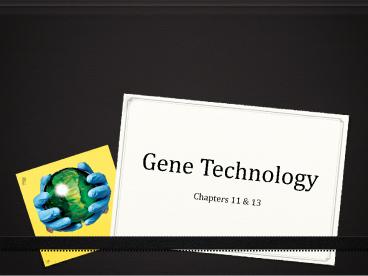Gene Technology - PowerPoint PPT Presentation
1 / 26
Title:
Gene Technology
Description:
Gene Technology Chapters 11 & 13 – PowerPoint PPT presentation
Number of Views:202
Avg rating:3.0/5.0
Title: Gene Technology
1
Gene Technology
- Chapters 11 13
2
Gene Expression
- Genome
- Our complete genetic information
- Gene expression
- Turning parts of a chromosome on and off
3
Gene Expression
- Uncoiled chromosomes are called euchromatin
- We have two parts to our genes
- 1. Introns
- Transcribed but not translated
- Cut out of mRNA before leaving nucleus
- 2. Exons
- Transcribed and translated
- Codes for a protein
http//highered.mcgraw-hill.com/olcweb/cgi/pluginp
op.cgi?itswf535535/sites/dl/free/0072437316
/120080/bio31.swf
4
Transcription
- DNA ? mRNA
- After mRNA has been made in the nucleus
- Introns are spliced out of the mRNA
- Exons bind together
- Addition of 5 cap and poly A tail
5
Gene Regulation
- Similar to bacteria except out genome is much
larger and more complex - 98 of our DNA does not code for a protein
- Each person has a specific number of non-coding
regions between exons - Called VNTR (Variable Number Tandem Repeats)
- Nonsense repeats in tandem
6
DNA Identification
- Used to identify criminals in a crime scene or to
see family relation - Four steps to use DNA identification
- 1. Isolate DNA (make copies if small sample)
- 2. Cut DNA in fragments that are known VNTR areas
- 3. Sort DNA by size (using technology)
- 4. Compare size fragments to known samples
http//www.youtube.com/watch?vZxWXCT9wVoI
7
How to Make DNA Copies
- Process called PCR
- Technology where a small DNA sample can be
amplified to many copies for analysis
8
PCR Steps
- 1. Add sample of DNA, DNA polymerase enzyme, free
nucleotides (to make new strands with) and heat
sample - The heat will act like helicase and separate the
strands of DNA
9
PCR Steps
- 2. Cool sample down so primers can be added to
DNA template strands
10
PCR Steps
- 3. DNA polymerase attaches to primers and adds
nucleotides to rest of DNA template strands
11
PCR Steps
- 4. Two new strands are made ? repeat process
until enough DNA sample
http//www.youtube.com/watch?v2KoLnIwoZKU
http//www.youtube.com/watch?veEcy9k_KsDI
12
Cutting DNA
- Technology that cuts long strands of DNA
- Biologists use restriction enzymes in order to
cut the DNA - Biological scissors
- Restriction enzymes can recognize specific
sequences and only cut in certain areas of DNA
13
Cutting DNA
- Sometimes when restriction enzymes cut DNA they
leave an overhang - Creates sticky ends where you can then add
recombinant DNA - Used to input DNA from other organisms into a
genome
http//highered.mcgraw-hill.com/olcweb/cgi/pluginp
op.cgi?itswf535535/sites/dl/free/0072437316
/120078/bio37.swf
14
Gel Electrophoresis
- Technology that separates DNA fragments by size
in a gel to compare to known samples
15
Gel Electrophoresis
- How to run a gel
- 1. DNA sample goes through restriction enzymes to
break into fragments of known VNTRs - 2. Each DNA sample (now cut up) gets added into
its own chamber well
16
Gel Electrophoresis
- 3. Electric current is run through the gel for a
specific amount of time - DNA is negatively charged
- End of gel is positively charged
- When current runs, the DNA fragments move towards
the end of the gel
17
Gel Electrophoresis
- 4. DNA is transferred to a nylon membrane where
probes are added - Probes bind to complementary DNA
18
Gel Electrophoresis
- 5. X-ray film exposes membrane
- This creates a band pattern that is unique to
each individual - Called a bio fingerprint
- You can create a permanent copy of results if
needed to file
19
Gel Electrophoresis
- How to read results
http//learn.genetics.utah.edu/content/labs/gel/
20
Recombinant DNA
- Genetic engineering modifying a genome of living
cell - When you combine two DNA strands from different
organisms it is then called recombinant DNA
21
Cloning
- Clone
- Exact copy of DNA, a cell or an organism
- Clones can be created by inserting DNA into
vectors - Vectors are organisms that can replicate itself
- Ex bacteria, yeasts
22
Cloning
- 1. Egg cells are extracted from one organism and
the nucleus is removed - Nucleus removed because the DNA of the organism
we want needs to fuse into the egg - Cells from organism we wish to clone are removed
23
Cloning
- 2. Desired organisms cell is placed next to egg
cell and electric shock fuses the two cells into
one - This triggers the new embryo to begin to divide
and develop
24
Cloning
- 3. Developing embryo is implanted in a surrogate
mother and after incubation period is over, a new
baby organism is born with the exact same genetic
information as original organism
http//www.youtube.com/watch?v-Qry1gYYDCA
http//www.youtube.com/watch?vtELZEPcgKkE
25
Vaccines
- Substance containing all or part of a harmless
strain of a pathogen - This gets introduced to our body and we build an
immunity for it creating a defense system against
the pathogen called antibodies - DNA vaccine vaccine containing genes from
pathogen but will not cause infection
http//www.youtube.com/watch?vSduMbjW2V9A
http//highered.mcgraw-hill.com/olcweb/cgi/pluginp
op.cgi?itswf535535/sites/dl/free/0072437316
/120078/bio39.swf
26
Agricultural Applications
- Made plants more tolerable to our environment
- Resistance to weeds
- Added genes that would be harmful to insects and
pests - Increase nutritional value to some plants
- Ex adding vitamin A to rice in Asia
http//www.youtube.com/watch?vFTfuAbzAeB8
food http//www.youtube.com/watch?vJVIznPgdQSM
animals































